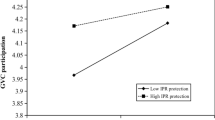Abstract
Taiwan’s economic strength has been rooted in its manufacturing base and in economies of scale. It started with a labor-intensive manufacturing boom in the 1950s and then progressed rapidly to the technology-intensive sector. The rapid industrialization and growth during the latter half of the 20th century created the ‘Taiwan miracle.’ In a recent report on global innovation and competitiveness published by the Economist Intelligence Unit in 2012, Taiwan today is ranked sixth globally and second in Asia; its current position is bolstered by a strong entrepreneurial spirit that is transforming Taiwan’s economy. However, Taiwan’s heavy reliance on the tech sector, which makes up about 40% of its GDP, also makes it vulnerable to global economic downturns and makes it necessary to seek new paths for national competitiveness at various levels.
Access this chapter
Tax calculation will be finalised at checkout
Purchases are for personal use only
Preview
Unable to display preview. Download preview PDF.
Similar content being viewed by others
References
Acs, Z.J. and Megyesi, M.I. (2007) ‘Creativity and Industrial Cities: A Case Study of Baltimore’, Entrepreneurship & Regional Development. An International Journal, 21(4), 421–439.
American Chamber of Commerce in Taipei (2011) 2011 Taiwan White Paper. Available from: http://www.amcham.com.tw/white-papers-2/cat_view/158-white-paper/283-2011/284-2011-white-paper-english, date accessed June 22, 2011.
Banks, M. and Hesmondhalgh, D. (2009) ‘Looking for Work in Creative Industries Policy’, International Journal of Cultural Policy, 15(4), 415–430.
Chao Y.M. (2011) ‘Rezoning Taiwan’, in Taiwan Review. Available from http://taiwanreview.nat.gov.tw/ct.asp?xItem=142515&CtNode=1337&mp=1, date accessed February 16, 2012.
Chen, L.M. (2010) A Report on Cultural, Creative Industries, Economy and Tourism Development after the Taichung City-County Merger. Taichung City Government Research Report.
Chun, A. (1994) ‘From Nationalism to Nationalizing: Cultural Imagination and State Formation in Postwar Taiwan’, The Australian Journal of Chinese Affairs, 31, January, 49–69.
Chung, H.L. (2012) ‘Rebooting the Dragon at the Crossroads? Divergence and Convergence of Cultural Policy in Taiwan’, International Journal of Cultural Policy, 18(3), 340–355.
Council of Cultural Affairs (2010) Law for the Development of the Cultural and Creative Industries. Available from: http://www.cca.gov.tw/ccaImages/laws/247/1-0-5.pdf, date accessed March 4, 2011.
Council of Cultural Affairs (2009) Creative Taiwan-Cultural and Creative Industries Development Project-Action Plan. Available from http://www.cci.org.tw/cci/upload/law/20100604104150-8dd3d038610f19c0bd08739c496f4052.pdf, date accessed January 17, 2011.
Council for Cultural Affairs (2004) The White Paper on Cultural Policy. Available from: http://english.cca.gov.tw/ct.asp?xItem=12192&ctNode=4063, date accessed January 19, 2011.
Executive Yuan, Taiwan (2002) Challenge 2008: Six-Year National Development Plan, Available from: http://www.gio.gov.tw/taiwan-website/4-oa/20020521/2002052101.html, date accessed March 12, 2011.
Florida, R. (2005) Cities and the Creative Class. (London: Routledge).
Taichung City Government (2012) Mayor Hu: A Cultural, Energetic New City. Available from http://eng.taichung.gov.tw/ct.aspx?xItem=12212&ctNode=1829&mp=18, date accessed November 15, 2012.
Jayne, M. (2005) ‘Creative Industries: The Regional Dimension?’, Environment and Planning C: Government and Policy, 23(4), 537–556.
Landry, C. (2000) The Creative City: A Toolkit for Urban Innovators. (London: Earthscan).
Miles, S. and Paddison, R. (2005) ‘The Rise and Rise of Culture-led Urban Regeneration’, Urban Studies 42(5/6), 833–839.
New Taipei City Official Website Introduction (2012) Available from http://foreigner.ntpc.gov.tw/_file/2968/SG/44813/D.html, date accessed December 11, 2012
Ponzini, D. and Rossi, U. (2010) ‘Becoming a Creative City: The Entrepreneurial Mayor, Network Politics, and the Promise of an Urban Renaissance’, Urban Studies 47(10), 1037–1057.
Scott, A.J. (2000) The Cultural Economy of Cities. (London: Sage).
Scott, A.J. (2006) ‘Creative Cities: Conceptual Issues and Policy Questions’, Journal of Urban Affairs 28(1), 1–17.
Taipei City Government (2012) Taipei Yearbook 2011. Available from http://tcgwww.taipei.gov.tw/mp.asp?mp=100095, date accessed November 9, 2012.
Yang, M.C. (2011) Promote the Central Taiwan CCI-CCI Fundamental Research Project, Commissioned Research by the Taichung City Government.
Editor information
Editors and Affiliations
Copyright information
© 2014 Hsiao-Ling Chung
About this chapter
Cite this chapter
Chung, HL. (2014). Developing the Creative Economy: The Network Approach of the Five Municipalities in Taiwan. In: Lee, HK., Lim, L. (eds) Cultural Policies in East Asia. Palgrave Macmillan, London. https://doi.org/10.1057/9781137327772_12
Download citation
DOI: https://doi.org/10.1057/9781137327772_12
Publisher Name: Palgrave Macmillan, London
Print ISBN: 978-1-349-46019-9
Online ISBN: 978-1-137-32777-2
eBook Packages: Palgrave Media & Culture CollectionLiterature, Cultural and Media Studies (R0)




